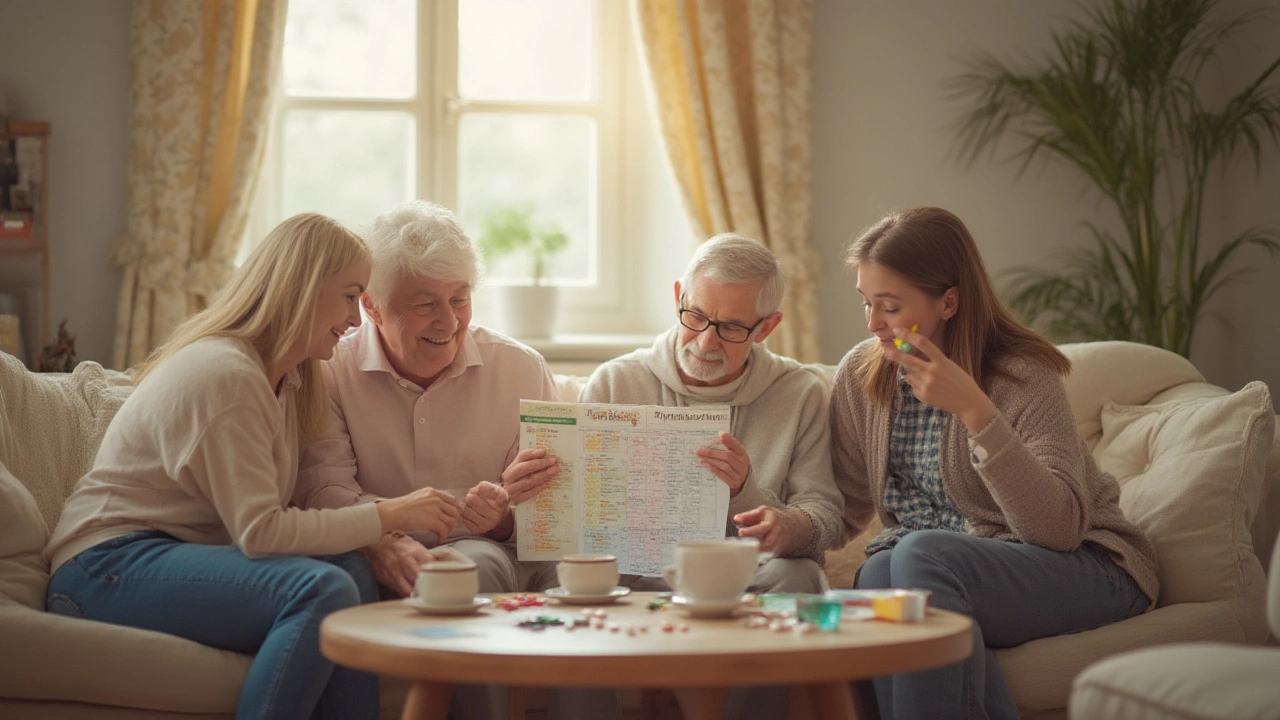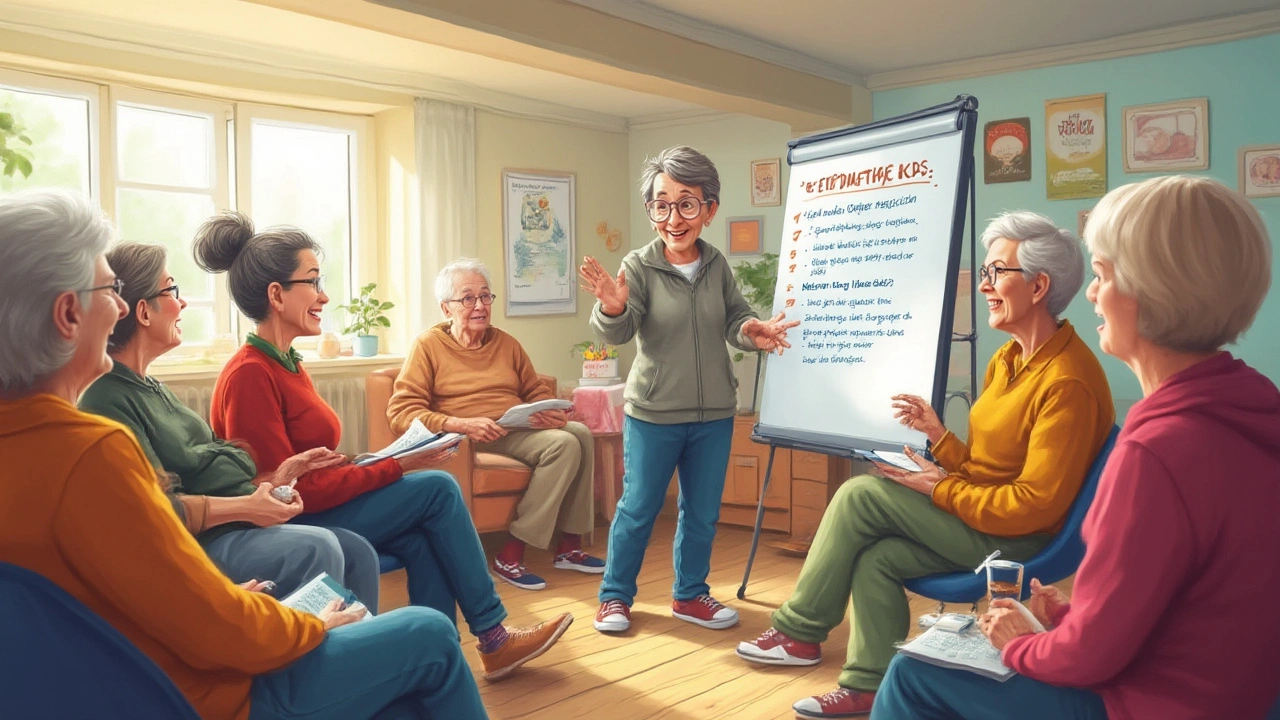
If you think the struggle of pain management in older adults is simple, think again. These folks are juggling more meds than a pharmacy shelf, kidneys aren’t firing at full power, and one bad fall can flip their whole life. Gabapentin gets prescribed all the time, but it’s honestly not always the best fit for the 65-plus crowd. Before you reach for another pill bottle, there’s a minefield of side effects, dosage headaches, and drug mix-ups to think through. So, what are the smarter moves if Gabapentin isn’t going to cut it?
Why Gabapentin Isn’t Always Ideal for Elderly Patients
Look, Gabapentin can give real relief for nerve pain, restless legs, or shingles aftereffects. But here’s the kicker: as age sneaks up, our bodies process things slower. Kidneys are especially sensitive, and Gabapentin is mainly cleared out through the kidneys. If your filters are moving slow, Gabapentin can stack up in your system, making dizziness, confusion, and even falls way more likely. It’s a real concern since 1 in 3 adults over 65 takes a tumble every year, sometimes with life-changing consequences.
That’s not all. Side effects like drowsiness, coordination problems, and blurred vision show up more often in seniors. A study published in JAMA found that among adults aged 75 and up, those who started Gabapentin had a 60% higher risk of unsteady walking or falling in their first two weeks on the drug. And we haven’t even talked about drug interactions yet—mixing Gabapentin with other sedatives boosts risks even more.
Add in the common issue of polypharmacy—where someone is taking five or more drugs? The chance of Gabapentin stirring up trouble goes through the roof. It’s clear: the hunt for safer, smarter alternatives is more than just a good idea.
The Problem of Polypharmacy: When More Isn’t Better
Polypharmacy sounds fancy, but it just means taking a bunch of different pills at once. Nearly 40% of people over 65 in the U.S. take five or more prescription meds. Every addition to that list can mean new interactions. Gabapentin, for all its pain-soothing virtues, doesn’t always play nicely with others—especially if those others are sedatives, sleeping aids, or anti-anxiety meds.
Let’s get specific. Combining Gabapentin with opioids or benzodiazepines is linked to dangerous breathing problems, even death. Even over-the-counter stuff isn’t always safe: diphenhydramine (your typical allergy relief) adds to sedation and balances issues. When you consider that a lot of elderly patients already need blood pressure medicine, diabetes drugs, and cholesterol-lowering meds, it’s not hard to see how the mix can get risky fast.
- Falls – Linked to up to 50% of injury-related deaths in seniors. Sedation and dizziness from overlapping meds are a huge part of this.
- Confusion/Delirium – Seniors metabolize drugs differently. Gabapentin and some of its alternatives can worsen memory and cognitive problems, especially when added to mood stabilizers or antipsychotics.
- Slowed breathing – Especially when used with other nervous system depressants.
In simple terms: piling on the pills without checking the whole picture can backfire badly. Any substitute for Gabapentin that also causes drowsiness or interacts with existing drugs needs a serious second look, which is why careful medication reviews make a world of difference.

Renal Dosing: Because Kidneys Deserve More Respect
A lot of doctors talk about liver safety in older patients, but kidneys often play the starring role in drug metabolism, especially with pain meds like Gabapentin. Roughly 40% of people aged 70+ have some kidney function loss, even if they feel fine. If the kidneys slow down, drugs can stick around longer than planned, raising the risk of overdose seriously fast.
Gabapentin is eliminated through the kidneys unchanged. Miss the mark on dosing, and you wind up with way too much in the bloodstream. This means for anyone with reduced kidney function (which, again, is super common in older adults), Gabapentin has to be dosed low and slow. Even then, there’s no guaranteed way to avoid side effects.
So, what actually works better? Some alternatives are metabolized by the liver or by several elimination routes, making them less likely to pile up in cases of renal insufficiency. But it’s not just about the organ—dose adjustments, frequency tweaks, and close follow-ups are all part of this balancing act.
| Medication | Main Route Out | Needs Kidney Dose Adjustment? | Key Risk in Seniors |
|---|---|---|---|
| Gabapentin | Kidneys (Renal) | Yes | Drowsiness, falls |
| Duloxetine | Liver | No (unless severe renal disease) | GI upset, high blood pressure |
| Pregabalin | Kidneys | Yes | Drowsiness, confusion |
| Amitriptyline | Liver | No (unless severe disease) | Confusion, constipation |
This quick snapshot shows that drugs like Duloxetine and certain antidepressants may, for some, be safer choices in terms of kidney workload—though they each come with their own set of risks if dosing isn’t careful.
Exploring Safe Substitutes for Gabapentin in Older Adults
So, let’s get practical: what are your real options if Gabapentin is looking sketchy? First, every alternative should be judged by three things—will it trigger falls, does it need kidney adjustment, and does it get tangled up with other meds?
- Serotonin-Norepinephrine Reuptake Inhibitors (SNRIs), like Duloxetine or Venlafaxine, are often used for nerve pain. Duloxetine especially stands out because it’s mainly processed by the liver, so it’s less likely to accumulate in those with kidney slowdown. Common issues to watch for: nausea, dry mouth, and sometimes blood pressure bumps.
- Tricyclic Antidepressants like Nortriptyline or Amitriptyline have been used for decades for neuropathic pain. They’re metabolized in the liver and don’t build up if kidneys slow down, but they can cause significant drowsiness, confusion, or constipation—three things nobody wants to deal with in their 70s or 80s.
- Pain Specialists Sometimes Suggest Topical Agents like lidocaine patches or capsaicin cream. These bypass the whole kidney/liver situation and go straight to the skin, which means side effects are mostly local—no full-body sedation or wrecked balance. They work best for pain in specific spots, like shingles scars.
- Physical Therapy and Non-Drug Strategies are underrated. Targeted exercises, gentle stretches, and even acupuncture or TENS units can sometimes reduce pain enough to avoid more meds entirely. These methods don’t add to fall risk or strain your kidneys, and there’s zero risk of drug interactions.
For a deep dive into even more substitutes for Gabapentin, check this comprehensive overview with honest pros and cons for each option. Keep in mind, there’s rarely a one-size-fits-all answer. What works safely for one person can spell trouble for another, depending on their health issues, other meds, and personal pain story.

Smart Strategies to Lower Fall Risk and Medication Overload
Avoiding falls is the gold standard for keeping older adults independent—and it starts with smart medicine choices. Here are some battle-tested tips:
- Review all meds with a pharmacist or geriatrician every six months. Be blunt—ask if each drug still earns its place on the list.
- Start low, go slow. If trying a new pain medicine (even a substitute), begin with the smallest dose that helps and gradually increase only if needed.
- Watch for hidden sedatives. Drugs for sleep, allergies, anxiety, or stomach cramps can quietly boost fall risk, especially if paired with Gabapentin-like meds or antidepressants.
- Time dosing smartly. Take sedative meds at night, when mobility is lower, but check for daytime drowsiness that could linger into waking hours.
- Focus on physical activity that builds strength and balance. Tai chi, yoga, and strength-training all reduce fall risk—no prescription required.
- Always ask about kidney and liver function before starting any new long-term med. Lab tests every year, minimum.
- If using patches, creams, or non-drug approaches, stick to one new method at a time to judge effectiveness and tolerance clearly.
Surprisingly, an Australian study from 2023 showed seniors who saw a pharmacist annually had a 30% lower hospital admission rate for drug-related falls. Sometimes, just having a second set of eyes on that pill list can save more than one headache—maybe even a broken hip.
Pain relief doesn’t have to mean more risks—especially not falls, confusion, or blown-out kidneys. The key is keeping choices simple, doses safe, and regular check-ins with doctors, pharmacists, and sometimes physical therapists or pain clinics. That’s how you outsmart the cycle of drug overload and keep moving strong into your 70s, 80s, and beyond.
Comments (17)
-
joshua Dangerfield July 23, 2025
Totally get the struggle of juggling meds, especially when kidneys start actin up.
-
Abhimanyu Singh Rathore July 24, 2025
Wow, the sheer complexity of polypharmacy in seniors is nothing short of a medical drama!!! The way kidney function declines silently while doctors keep adding pills feels like a ticking time bomb-dangerous and avoidable. Your guide shines a light on that hidden peril, and I appreciate the detailed fall‑risk stats-truly eye‑opening! It’s also great that you highlighted topical options; they’re often the unsung heroes in pain management. Keep the thorough breakdown coming, because clarity saves lives!!!
-
Stephen Lewis July 24, 2025
Indeed, the evidence you cite underscores the necessity for vigilant medication reconciliation. A systematic review confirms that dose adjustment based on renal clearance markedly reduces adverse events. Accordingly, clinicians should incorporate regular renal function monitoring into standard practice.
-
janvi patel July 24, 2025
While guidelines are helpful, real‑world adherence often falls short.
-
Lynn Kline July 24, 2025
Hey there, champion of senior safety! Let’s talk about why swapping Gabapentin isn’t just a checkbox on a form-it’s a lifeline for balance and brain clarity. Imagine a world where a simple dose tweak keeps your grandma from wobbling down the hallway, where the liver‑processed duloxetine does its job without clogging the kidneys. The table you shared makes the comparison crystal‑clear, and the side‑effect profile reads like a vivid cautionary tale. I love how you tossed in non‑drug options too; a gentle stretch or a snug lidocaine patch can be just as heroic. Your balanced mix of science and practical tips feels like a friendly roadmap for caregivers. Keep the empowering advice flowing, because every senior deserves a steady step forward!
-
Rin Jan July 25, 2025
When we talk about medication choices for the elderly we must first acknowledge that the health system often treats seniors as containers for endless prescriptions without truly weighing the moral cost of each added pill. The reality is that each drug carries a hidden burden of side effects that can erode dignity and independence in ways that are rarely measured in clinical trials. Gabapentin, for instance, may soothe nerve pain but its renal clearance demands such careful titration that many clinicians simply overlook the subtle signs of toxicity. Patients with even mildly reduced kidney function can accumulate the drug to dangerous levels, leading to dizziness that precipitates a fall and a broken hip. A broken hip is not just a physical injury; it often triggers a cascade of depression, loss of autonomy, and increased mortality. Therefore the ethical responsibility of prescribers extends beyond alleviating pain to safeguarding the whole person from preventable harm. Alternatives like duloxetine offer a different metabolic pathway, yet they introduce their own set of challenges such as blood pressure elevation that must be monitored. Topical agents bypass systemic absorption altogether, providing localized relief without the systemic toxicity that plagues many oral agents. Physical therapy, though underutilized, can empower patients to regain strength and stability, reducing reliance on any pharmacologic solution. When a care plan incorporates these non‑drug strategies it reflects a holistic view that respects the patient's quality of life. Neglecting to adjust doses according to renal function not only violates best practice but also breaches the trust between doctor and patient. The literature consistently shows that dose reductions based on creatinine clearance dramatically lower the incidence of adverse events. In contrast, stubborn adherence to standard dosing without adjustment is a textbook example of medical hubris. Patients deserve a transparent conversation about why a lower dose or a different medication might be safer. Ultimately, the goal is to balance pain relief with the preservation of mobility, cognition, and overall well‑being.
-
Jessica Taranto July 25, 2025
I appreciate the thorough breakdown of each alternative and the clear emphasis on renal safety; it really helps clinicians make informed choices. The inclusion of non‑pharmacologic options like TENS and acupuncture adds valuable depth. It’s also reassuring to see the practical tip about timing sedative medications at night. Overall, this guide feels both comprehensive and accessible for busy practitioners. Thanks for sharing such a balanced resource.
-
akash chaudhary July 25, 2025
The analysis is solid, but it glosses over the fact that many of these “alternatives” lack robust head‑to‑head trials against gabapentin. Moreover, prescribing duloxetine indiscriminately can exacerbate hypertension in vulnerable patients. Clinicians need hard data, not just hopeful anecdotes.
-
Adele Joablife July 25, 2025
The guide does a good job of highlighting the pitfalls of polypharmacy, yet it could have delved deeper into medication review protocols. For instance, integrating a pharmacist‑led reconciliation every six months often uncovers unnecessary drugs. Also, while topical agents are mentioned, their cost and insurance coverage can be barriers for many seniors. A brief discussion on navigating those financial hurdles would strengthen the piece. Nonetheless, the emphasis on renal dosing is spot‑on and highly relevant. Keep up the thorough work.
-
kenneth strachan July 25, 2025
Sounds like you’re overcomplicating a simple switch-it’s not that hard.
-
Mandy Mehalko July 26, 2025
This is exactly the kind of practical, patient‑centered information we need-thanks for the clear tables and the focus on safety! I love that you didn’t just dump a list of drugs but actually explained how each one fits into a senior’s daily routine. The suggestion to involve physical therapy is golden; movement really does prevent a lot of the dreaded falls. Even the small tip about checking kidney labs yearly can save a lot of trouble later. Keep the helpful guides coming!
-
Bryan Kopp July 26, 2025
While the advice is solid, implementation can be challenging in under‑resourced settings. A concise checklist might aid busy clinicians.
-
Patrick Vande Ven July 26, 2025
The presented data aligns with existing consensus statements regarding renal dose adjustments for gabapentin. It is imperative that prescribers assess glomerular filtration rate prior to initiation of therapy. Furthermore, incorporating interdisciplinary reviews can mitigate adverse drug events. The authors have succeeded in delivering a concise yet comprehensive overview.
-
Tim Giles July 26, 2025
Indeed, the necessity of a multidisciplinary approach cannot be overstated, as it facilitates the integration of pharmacologic and non‑pharmacologic modalities in a cohesive treatment plan; moreover, the longitudinal monitoring of renal parameters ensures that dose modifications are both timely and evidence‑based, thereby reducing the probability of accumulation‑related toxicity. When clinicians collaborate with pharmacists, the likelihood of identifying redundant or interacting prescriptions increases substantially, which in turn fosters a safer therapeutic environment for the elderly patient population. Additionally, patient education regarding potential side effects empowers individuals to report early signs of dizziness or confusion, leading to prompt adjustments before a fall occurs. The inclusion of physical therapy as a cornerstone of pain management further underscores the need to address musculoskeletal health alongside neuropathic pain, creating a synergistic effect that may diminish reliance on medication. Moreover, the economic implications of preventing hospital admissions due to falls present a compelling argument for implementing these comprehensive strategies. It is also worth noting that emerging evidence suggests that topical agents, when appropriately selected, can provide comparable analgesia with a markedly reduced systemic burden. Consequently, the synthesis of these various elements-renal dosing vigilance, interdisciplinary collaboration, patient engagement, and alternative therapies-constitutes an optimal framework for senior pain management. In summary, the evidence presented reinforces the call for a nuanced, patient‑centered approach that balances efficacy with safety.
-
Peter Jones July 27, 2025
I think the guide hits the sweet spot between technical detail and readability. It offers real‑world advice without drowning the reader in jargon. Kudos to the author for such a balanced piece.
-
Gerard Parker July 27, 2025
Thank you for the kind words; the intention was to bridge the gap between research and bedside practice. As a cultural ambassador, I also aim to respect diverse patient backgrounds when discussing medication choices. The aggressive stance on regular medication reviews reflects the urgency of preventing avoidable injuries. Together, these perspectives help craft a more inclusive and effective care model.
-
Thomas Burke July 27, 2025
Great info and easy to read I love the focus on safety and kidney health
